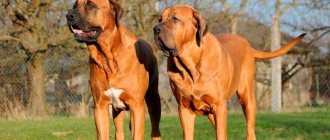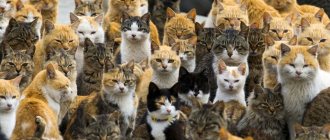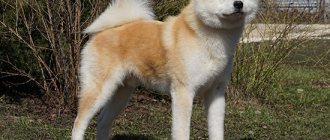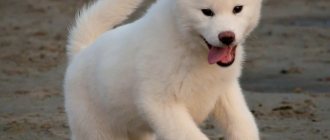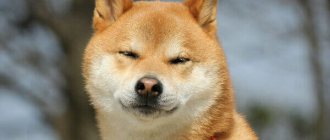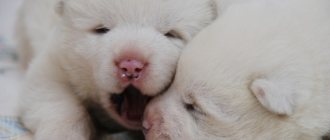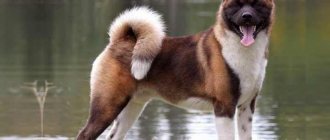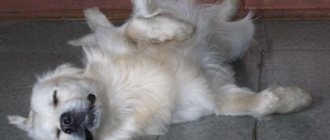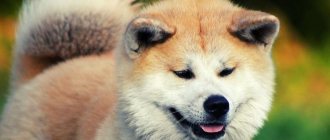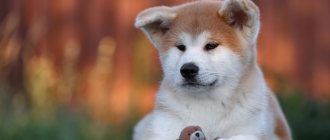The American Akita (akita american) is a young dog breed that is rapidly gaining popularity around the world. Their colorful appearance and strength, which is noticeable to the naked eye in these dogs, make them desirable pets for many dog breeders. However, it should be understood that a harmonious appearance does not guarantee a soft and flexible character.
History of the origin of the dog
The ancestors of this breed are Japanese Akita Inu, dogs that were originally used for hunting and guarding. In the 19th-20th centuries, when dog fighting became fashionable, the owners of Akita Inu, or, as they were called before, Matagi Akita, began to use their pets for fights. The desire to make the Akita Inu larger and stronger to win in battles led to the crossing of these dogs with mastiffs and shepherd dogs and their gradual loss of classic breed traits.
This was discovered in 1914 at an exhibition held in Tokyo. After this, purebred representatives of the breed were declared natural monuments, interbreed matings were prohibited, and breeders began work to return the Matagi Akita to its original characteristics.
Due to a government decree, during World War II, breeders were required to donate dogs for the needs of the front. When the war ended, American soldiers returned home and took several puppies with them. It was they who, a few years later, laid the foundation for the emergence of a new breed, the representatives of which were initially called “large Japanese dogs.”
Breeders from the USA and Japan carried out work on the development of breeds in parallel, without coordinating them with each other. This was the reason for the emergence of serious differences in the character and appearance of American and Japanese Akitas.
The breeds were officially separated in 2000 when the FCI approved the American Dog Standard.
History of origin of the breed
The first written mentions of the breed date back to the 17th century, and the roots of this breed come from Japan. Previously, the breed was called the Big Japanese Dog, and in the 50s of the twentieth century a new history of the breed began in the USA, when it became known as the American Akita. The American Akita is believed to be an offshoot of the Akita Inu breed, and the American can trace its origins back to the ancient Akita Inu dogs. After the end of World War II, American soldiers took Akita representatives to their homeland, and a new history of breeding the breed began there, and to this day it is popular and revered there.
Differences from Japanese
Japanese Akita Inu.
The main differences between American Akitas:
- the standard allows any coat color and the presence of a mask on the face;
- representatives of this breed are larger than Japanese Akitas;
- they have a softer undercoat and hard outer hairs.
Also, “Americans” are distinguished by pronounced leadership qualities and a tendency to fight.
Description of the Akita Inu breed
If you look at any Encyclopedia, the description of the main characteristics of this variety will be reduced to a listing of well-known facts. Akita Inu is a Japanese Spitz-type dog that was bred in the northern regions of the Land of the Rising Sun. Moreover, according to the modern definition, the Japanese dog is not a 100% hunting dog, but a “semi-functional” one. That is, hunting is not the main purpose of modern representatives of this breed. True, the residents of Japan are ready to argue with this, as they call these beauties “The Treasure of the Country.”
As for character, not a single encyclopedia is able to fully convey the character traits of these handsome men, who are as calm and balanced as the samurai, but at the same time just as brave and warlike.
Harmony in everything. This is the description that best suits representatives of the Akita Inu breed. The Japanese Akita is distinguished by its original appearance, in which there is nothing superfluous, and an oriental noble character. And, despite the fact that Akita is a Japanese dog, both in appearance and in its character traits it corresponds to European canons and standards of the canine ideal.
The first thing that catches your eye is its classic appearance. Only the subtle details of the Akita Inu give away its Japanese origin (see photo). The animal’s head is broad-browed and large, however, like its paws, they are massive and stable. But the ears of the original shape, similar to pockets, give it a similarity at the same time with a fox, wolf, and bear. But overall, these are strong dogs, large and well-cut, well-behaved.
The uniqueness of the appearance does not even lie in the similarity with wild animals, but in the fact that the beauty of the Japanese dog is a merit of nature, since man, despite the fact that he tried to carry out certain crossings, did not influence the appearance of the Akita Inu breed in any way (see photo ).
A male at the withers reaches a height of 75 cm, but must be at least 64 cm. Males weigh at least 40 kg. As for the female part of the species, the mass and also the size are smaller.
For representatives of this variety, three color options are allowed:
- red and white. In this case, white color can only be on the inner surface of the chest and paws, on the muzzle, in the form of a mask. Professionals call this muzzle color “urajiro”;
- brindle with a white mask on the muzzle;
- white: white coat without patches, but the nose is black (see photo). The white Akita Inu was only bred in the last century, but the color is designated in the Japanese standard.
The presence of a black mask on the face is allowed only for representatives of American Akita Inu dogs, but not for Japanese ones (see photo).
Description of breed characteristics
American Akitas are strong, large, harmoniously built dogs with a powerful body and massive bones. Their confidence and power can be felt even in their gait: representatives of this breed have strong, free movements with a moderate lunge and push.
Types by coat type
Representatives of this breed can be:
- long-haired - such dogs have a plentiful head and tail covered with hair, and the elongated fur on the paws forms “pants”;
- short-haired - these individuals have a double coat, consisting of coarse, straight guard hairs and a shorter, soft and dense undercoat.
It is believed that the long-haired representatives of the breed were obtained accidentally as a result of a genetic failure.
Longhaired Akita Inu.
Appearance
In accordance with the breed standard for the American Akita:
- large head, flat and wide skull between the ears with a well-defined but not sharp stop;
- wide, black nose (for individuals with white fur, blurred color or slight depigmentation is acceptable);
- black, non-sagging lips;
- powerful jaws, scissor bite;
- the eyes are small, triangular, the iris is dark brown;
- the ears are small, erect, V-shaped, wide at the base;
- the neck is thick, short, with developed muscles, the scruff is convex;
- the back is straight, the lower back is muscular;
- The chest is wide and deep, the ribs are arched;
- the stomach is moderately tucked;
- the tail is set high, abundantly covered with hair, curved into a ring;
- the limbs are straight, strong and muscular, the paws are “cat-like”.
The coat is double, consisting of straight, coarse guard hair and thick, soft and dense undercoat. Disqualifying defects include depigmentation of the nose, overshot or undershot, semi-erect or hanging ears, straight or crescent-shaped tail, cryptorchidism in males, aggressive behavior, and cowardice.
Males grow to 66-71 cm at the withers and weigh 45-65 kg, females reach a height of 61-66 cm with a body weight of 32-45 kg.
Character
American Akitas have a difficult character. They are independent, willful and freedom-loving, love to control everything and always strive to take a leadership position. At the same time, these are calm and affectionate dogs with a balanced psyche, who rarely bark and always behave with dignity and restraint. Representatives of this breed are infinitely devoted to their owner, yearn in his absence and need constant communication. However, they also require personal space and will never impose themselves if they see that the owner is busy. The main thing for these dogs is to feel care and attention.
“Americans” are fearless, they are born guards and defenders. Therefore, they treat strangers quite warily and with distrust. They need time to get used to people and greet guests in a friendly manner. They have difficulty getting along with other animals. Oddly enough, Akitas are more loyal to cats, while in dogs, especially males, they see exclusively as rivals with whom they need to fight for leadership.
Representatives of this breed are intelligent, but quite difficult to train due to the habit of always acting independently. The owner will need to show patience, persistence and leadership skills to gain the pet's respect and obedience.
Peculiarities
These dogs are excellent hunters. This trait cannot be suppressed in them - it will manifest itself one way or another, and probably not from the best side for the owner. For example, a pet will begin to regard birds, cats, or smaller dogs as prey on walks. From the Japanese Akita Inu, the “Americans” have inherited incredible devotion - they literally depend on their owner and have a hard time bearing his loss. That is why they are often called a one-owner dog.
These dogs have excellent memory and remember how they are treated. Therefore, you should not shout at the puppy, treat him with disdain, and especially punish him physically. The pet will remember this and hold a grudge. In this case, it will be difficult to regain his favor and gain respect again.
Advantages and disadvantages
American Akitas, like other breeds, have their pros and cons. Among the indisputable advantages of these dogs are:
- loyalty and devotion;
- stable psyche;
- hunting and protective instincts;
- ability to get along with children;
- cleanliness;
- courage;
- possibility of street maintenance;
- high life expectancy;
- ease of care;
- intelligence and intelligence;
- rare barking.
Disadvantages of American Akitas:
- stubbornness and love of freedom;
- heavy shedding;
- desire for dominance;
- Possibility of aggressive behavior towards other dogs.
In addition, these dogs need regular long walks and physical activity, which many also regard as a disadvantage of the breed.
Lifespan
Representatives of this breed live on average 10-14 years.
Color
The breed standard for American Akitas allows for any coat color. The most common options with photos:
- white - the coat is solid white, the lips, nose and paw pads are pigmented black, there is no mask or spots;
- Pinto - the main color of the coat is white, there are spots of a different color on it, covering a third of the body and the muzzle, the mask is black or black and white or there is none at all;
- fawn – the coat is light, without yellowness or redness, a black mask may be present;
- brindle - on the main yellow, fawn, brown or gray color of the coat there are transverse dark stripes.
The shade of the undercoat may be slightly darker or lighter than the main coat color.
White.
Pinto.
Brindle.
Breed dossier
- Country of origin : Japan, United States of America.
- Classification : Group 5. Northern sled dogs, Spitz, primitive. Section 5. Asian Spitz and related breeds.
- Training : representatives of the American Akita breed need space and great physical activity. When trained, these dogs do not tolerate bullying and humiliation. They need a strong, worthy owner-partner, not a commander. When training these dogs, a special approach is required.
- Color : white, fawn, red, brindle, piebald.
- Dimensions . Height at withers: males: 66-71 cm (26-28 inches), females: 61-66 cm (24-26 inches). Weight: females: 45 – 55 kg, males: 50 – 65 kg.
- General impression : a fairly large dog with harmonious body proportions, strong and independent.
- Usage . Previously, American Akita dogs were used as fighting and guard dogs. Now representatives of the breed have shown their universal qualities, and they are used in security, in the police, as guide dogs and as companion dogs.
- Physical activity : representatives of the American Akita breed need space and great physical activity. A long daily walk of the dog in a park or other open space is required.
- Personality : friendly, responsive, brave. These dogs can sometimes be proud and independent.
- Contents : well suited for keeping in a private house with a large yard, in an aviary. In a city apartment, these dogs can feel cramped and uncomfortable; from lack of exercise, they can become lethargic and begin to get sick.
- Grooming : caring for the thick coat of American Akitas is not very labor-intensive, but thorough. They need to be brushed well a couple of times a week, more often during the molting period (winter and autumn).
- Accommodation : May not get along very well with other pets, as this dog is somewhat jealous, and prefers to be the center of attention for its owner and his family, fighting for undivided attention.
- Diseases : representatives of this breed have excellent health, and with proper care they should not get sick. No severe hereditary diseases have been identified in American Akitas.
- Diet : balanced. Dry food and supplementary food from natural products.
- Life expectancy : 10-12 years.
Photo: American Akita (Akita Matagi or Great Japanese Dog)
Table of weight and height by month
| Age | Height at withers, cm | Weight, kg | ||
| Male | Bitch | Male | Bitch | |
| 2 months | 35-38 | 31-35 | 8-9 | 7-8 |
| 3 months | 38-43 | 35-41 | 13-15 | 11-14 |
| 4 months | 43-51 | 41-48 | 18-21 | 15-18 |
| 5 months | 51-56 | 48-54 | 22-25 | 20-22 |
| 6 months | 56-61 | 54-58 | 27-30 | 24-26 |
| 9 months | 61-63 | 58-61 | 32-36 | 28-32 |
| 1 year | 63-67 | 61-64 | 36-39 | 34-38 |
| 18 months | 67-71 | 64-66 | 40-44 | 38-42 |
The data given in the table is averaged. Minor deviations are not a cause for concern.
Feeding
Representatives of this breed can be fed with natural products or industrial dry food. Each type of feeding has pros and cons, so there is no clear answer which one is better. The choice depends on the views and preferences of the dog owner, the main thing is not to mix them.
The number of daily feedings depends on the age of the pet:
- 2 months – 5 times;
- 4-5 months – 4 times;
- 6-8 months – 3 times;
- 9 months and older – 2 times.
With a natural diet, the dog’s diet should include:
- dietary meat (beef, rabbit, turkey) raw or scalded with boiling water;
- cereals (rice, buckwheat);
- boiled sea fish;
- low-fat fermented milk products (yogurt, kefir, cottage cheese);
- eggs (no more than once a week);
- offal (lung, liver, tripe, heart);
- seasonal fruits and vegetables (carrots, zucchini, apples);
- sea kale.
It is prohibited to give your pet:
- fat meat;
- spicy food;
- sweets, pickles, seasonings, smoked foods, marinades;
- garlic, onion;
- bakery and pasta products;
- tubular bones;
- river fish;
- legumes
When eating natural foods, vitamin-mineral complexes (Unitabs Brevers Complex, Beaphar Doggys, Radostin) are additionally included in the diet.
Approximate weekly diet for an adult:
| Day of the week | Menu |
| Monday | 600 g turkey, 400 g rice porridge, 400 ml kefir, 500 g vegetables |
| Tuesday | 800 g beef, 400 ml yogurt, 400 g vegetables, 400 g rice porridge |
| Wednesday | 1 kg of sea fish, 300 g of buckwheat porridge, 400 g of cottage cheese, 500 g of vegetables, 2 tsp. seaweed |
| Thursday | 600-800 g beef, 300-400 g rice porridge, 400 g cottage cheese, 400 g vegetables, 2 tsp. seaweed |
| Friday | 1 kg of sea fish, 300 g of buckwheat porridge, 500 g of cottage cheese, 300 g of vegetables, 2 tsp. seaweed |
| Saturday | 1 kg of sea fish, 300 g of buckwheat porridge, 500 g of cottage cheese, 1 egg, 400 g of vegetables |
| Sunday | 800 g rabbit meat, 400 g buckwheat porridge, 500 g cottage cheese, 400 g vegetables, 2 tsp. seaweed |
If the choice falls on industrial feed, you should not purchase economy class products. These foods do not contain the vitamins and minerals necessary for a dog’s growth and development; they contain a lot of grains and meat waste. Premium or super-premium food is suitable for American Akitas. Products from the brands Hills, Royal Canin, Monge, and Bosch are popular among breeders.
Akita Inu and Shiba Inu: main differences
Those who have never seen an Akita Inu and a Shiba Inu in person may confuse the dogs. But these are two different breeds. Although from one section of Asian Spitz. However, animals have significant differences.
In the Russian language, two names for the breed have taken root: Shiba Inu and Shiba Inu. But from a linguistic point of view, the option with the letter “c” is more correct. There is no "sh" sound in Japanese.
Size
Shiba Inu
This is the key difference between the two breeds. Akita Inu are large dogs, reaching 67 cm in height. Shiba Inu is one and a half times smaller - up to 40 cm.
The Shiba Inu is more suitable for apartment living due to its compact size. Akita can also be kept in a multi-storey building, but they feel better on a plot.
Purpose
Akita was bred as a fighting, hunting, and guard dog. The main purpose of the Shiba is hunting. Representatives of the breed also cope with the role of guards.
But if an Akita Inu can silently attack a stranger, then a Shiba Inu only signals danger with a ringing bark.
Character
Shiba Inu
Akita Inu are more independent. They love solitude and do not get along well with other animals. They are loyal to children, but are more suitable for children of middle and high school age. Toddlers' annoying behavior irritates them. Akita Inus are only playful when they are puppies. Adults can only occasionally frolic with other dogs.
Shiba Inus get along better with family members and pets. They are many times more sociable than an Akita. Pets are easy-going and playful, so they are often trained in agility.
Choosing a nickname
If the puppy was purchased from a kennel and has the necessary documents confirming its pedigree, it already has a name. Breeders give official nicknames to each puppy in the litter, based on the rules of the club. So, most often the nickname begins with a letter corresponding to the serial number of the litter, reflects a certain theme and contains the name of the father or the name of the club. This nickname is used, for example, at exhibitions.
At home, the puppy can be called any name you like. The main thing is that it matches the dog’s character and reflects its characteristics. Often, owners strive to emphasize the pet’s roots by choosing a Japanese nickname, which not only sounds beautiful, but also carries a certain meaning:
- Aki – born in autumn;
- Yoshiko is a good child;
- Keiko – beloved;
- Kyoka – happy;
- Takara is my treasure;
- Fuku – lucky;
- Akina - spring;
- Yume is a dream;
- Hana – flower;
- Toshi – reflection;
- Chico – swift as an arrow;
- Miki – flower stem;
- Katana is as dangerous as a Japanese sword;
- Sakura – cherry blossom;
- Ichigo is a strawberry.
Also popular are nicknames such as Adam, Bonnie, Willie, Hector, Jerry, Zeke, Kevin, Lyon, Morty, Nikki, Oscar, Patrick, Robbie, Sims, Teddy, Phoebus, Hugo, Charlie, Athena, Bertha, Vicky, Gabi, Dina , Irma, Carla, Lara, Mirta, Nika, Pixie, Runa, Santa, Tora, Frida, Sherry.
Diseases
American Akitas have good health and good immunity. However, there are a number of diseases characteristic of representatives of this breed:
- allergic reactions;
- volvulus;
- retinal atrophy;
- cataract;
- hip dysplasia;
- seborrheic adenitis;
- hypothyroidism;
- dermatitis;
- Cushing's syndrome;
- pemphigus foliaceus;
- inversion and eversion of the eyelids;
- hyperkalemia;
- epilepsy.
In addition, these dogs often experience intolerance to anesthesia and hormonal imbalance, leading to infertility.
Care and maintenance
These dogs can be kept in an apartment only if it is large enough and has air conditioning so that the pet does not overheat. Also in this case, the dog must be walked at least twice a day for 1-1.5 hours. Thanks to their dense and dense wool, representatives of this breed are not afraid of cold weather, so the most suitable housing option for them is an equipped spacious enclosure with a booth.
These dogs should not be kept on a chain - this negatively affects their character, provoking anger and aggressive behavior.
“Americans” are taught to be muzzled from an early age. It is necessary when completing a course of OCD, and will also help protect your pet and avoid the possibility of poisoning during walks, preventing it from picking up spoiled food from the ground and eating it. Caring for representatives of this breed is easy. It consists of regular hygiene procedures, to which the dog is taught from puppyhood.
Wool and bathing
The coat of American Akitas is not prone to matting and matting, so it is enough to brush it 1-2 times a week with a metal comb. During seasonal shedding (spring and autumn), the coat is combed daily with a furminator or slicker brush - this helps get rid of dead hair and improve the dog’s blood circulation. After each walk, wipe the pet’s paws with a damp towel and inspect them for injuries and cracks.
Representatives of this breed are bathed as needed, approximately once a quarter, using a special shampoo appropriate for their coat type.
Eyes
The eyes are examined regularly and wiped with a soft, lint-free cloth to remove small gray lumps that may appear in the corners of the eyes. In case of increased lacrimation, swelling of the eyelids and excessive acidification, it is necessary to show your pet to a veterinarian.
Ears
The ears should be pink, without excess wax. They are inspected weekly and wiped with a cotton pad soaked in a special lotion or hydrogen peroxide. If there is a large accumulation of earwax, an unpleasant odor or redness, you should contact a specialist to determine the cause of their appearance.
Teeth
To prevent the formation of plaque and tartar, your pet’s teeth should be brushed 3-4 times a week using dog paste and a special brush or finger attachment.
Claws
Nails are trimmed every 3-4 weeks using a guillotine nail clipper for large breeds. Sharp edges are smoothed with a nail file to avoid chips and burrs.
Caring for your pet also involves timely vaccination and deworming.
Akita Inu care
Caring for an Akita involves feeding and general hygiene.
Feeding your Akita should be as balanced and complete as possible. This is an active and large dog, prone to joint problems, so it needs high-quality nutrition. If it is food, then only holistic or super-premium. Natural nutrition may include the following products:
- fermented milk products (cottage cheese, kefir, unsweetened yogurt, etc.);
- cheese (not salted);
- egg (no more than 2 pieces per week);
- meat (lean, not pork or fish);
- boiled liver, kidneys, lungs;
- cereals for porridge (buckwheat, rice, pearl barley);
- boiled vegetables (carrots, zucchini, tomatoes, pumpkin);
- fruits (for Akitas older than 4 months - pears, apples and others);
- vegetable oil (add 1 tbsp to porridge) - good for hair health.
Akita needs to eat properly
It is not recommended to experiment with other natural products. The dog is fed from 6 months. 2 times a day strictly according to schedule, for younger puppies - 3 times a day. If an Akita does not lead a very active lifestyle, it may refuse to eat and eat once every 1-2 days. Clean fresh water must be available at all times.
General hygiene includes caring for the coat, ears and teeth.
The Akita's coat requires 2-3 brushings per week with a thick brush. The Furminator can be used no more than once a week. During the molting period, combing is done 4-5 times a week. The Akita is washed 2-3 times a year, as it is clean and does not have a pronounced dog smell. Grooming your Akita is not recommended.
The Akita's coat needs regular brushing.
The ears are cleaned with a special lotion and cotton wool 1-2 times a week. Teeth are brushed every 2-3 days with toothpaste and a dog brush. It is not necessary to cut the nails, but you can do it once every 2-4 weeks. Be sure to worm and protect your dog from fleas and ticks, follow the vaccination schedule and regularly visit the veterinarian.
Choosing a puppy and its cost
It is better to purchase a puppy from a specialized nursery from professional breeders - this minimizes the risk of buying a sick dog or a mixed breed. First you need to inspect the living conditions of the animals, meet the parents of the future pet, learn about their character and health.
In a healthy standard American Akita puppy:
- shiny, soft wool;
- clean eyes and ears, no increased lacrimation;
- cold nose;
- no rashes or redness on the skin;
- scissor bite.
The puppy should be active, cheerful and inquisitive; there should be no signs of aggression or cowardice in his behavior. The cost of an American Akita puppy depends on the class to which it belongs. Thus, the average price of a pet class representative is 10-15 thousand rubles, a breed class representative is 15-30 thousand rubles, a show class representative is from 45 thousand rubles.
Standard Akita – Akita kennel, Akita rossia cara kennel
Akita Inu FCI Standard
GENERAL FORM:
A large, well-built dog, well balanced, powerful and solid in build; secondary sexual characteristics are strongly expressed; the dog has a noble appearance; has modesty and self-esteem; type of constitution - strong.
IMPORTANT PROPORTIONS:
The ratio of the height at the withers to the length of the body (from the shoulder protuberance to the ischial tuberosity) is 10:11, while the body of females is longer than that of males.
BEHAVIOR AND TEMPERAMENT:
temperament is reserved, loyal, obedient and receptive.
HEAD Cranial region:
the skull has the shape of an obtuse triangle, the size is proportional to the body.
The forehead is wide, with a distinct hollow in the middle. No folds. Stop: expressed. FACIAL REGION: Nose:
large and black, with white color - all shades of liver.
Muzzle:
Moderately long, powerful, with a wide base, tapering towards the nose, but not pointed. The bridge of the nose is straight.
Lips:
Tight fitting
Jaws/Teeth:
Powerful teeth, scissor bite.
Cheeks:
moderately developed.
Eyes:
relatively small, raised outer corners give them an almost triangular shape, moderately spaced, dark brown: the darker the better.
Ears:
relatively small, thick, triangular in shape with slightly rounded tips, moderately spaced, erect, inclined forward.
Neck:
Thick and muscular, without dewlap, in proportion to the head.
BODY Back:
straight and strong
Loin:
wide and muscular
Chest:
deep, with a well-developed front, ribs moderately arched.
Belly:
well tucked.
Tail:
set high, thick, carried vigorously over the back (preferably in one full ring);
when lowered, the tip of the tail almost reaches the hock joints. LIMBS Forelegs Shoulder:
moderately sloping, well developed.
Elbows:
tightly pressed to the body.
Forelegs:
straight, with strong bones.
Hindquarters:
Well developed, powerful, moderately angulated.
Paws:
thick, round, arched, stable.
Movement:
elastic, powerful push.
Coat:
the outer coat is hard and straight, the undercoat is soft and thick; the hair on the withers and rump is slightly longer; the hair on the tail is longer than on the body.
Color:
red, brindle and white. With all the above colors, with the exception of white, the dog must have “urajiro” (urajiro-white hair on the sides of the muzzle, on the cheekbones, the lower surface of the jaw, on the front of the neck, the inside of the chest of the body and the inside tail, inner parts of legs).
SIZE:
male - 67 cm, female - 61 cm. Deviation from the above dimensions is allowed no more than 3 cm in any direction.
FAULTS: Any deviation from the above requirements is considered a fault and its severity is assessed strictly in proportion to its severity. - deviation from the sexual type (sexual demophism must be clearly pronounced) - overshot or undershot - incomplete teeth - tongue with blue or black spots - lightened iris - short tail - timidity DISQUALIFYING FAULTS:
non-erect ears, hanging tail, long hair (shaggy) ,black mask, markings on a white background.
Males must have two normal testes fully descended into the scrotum

